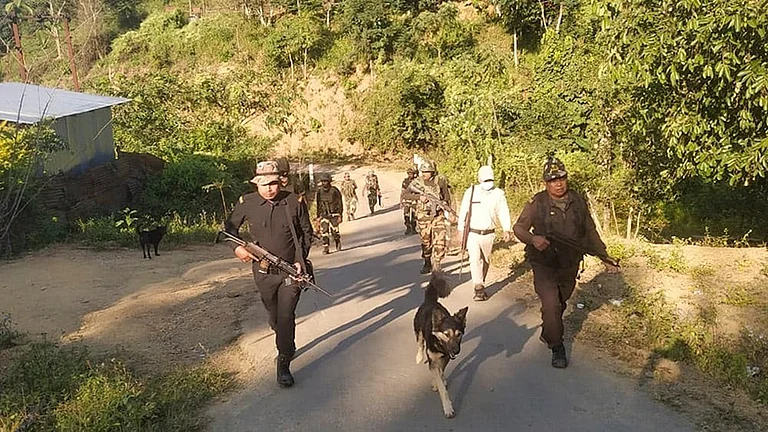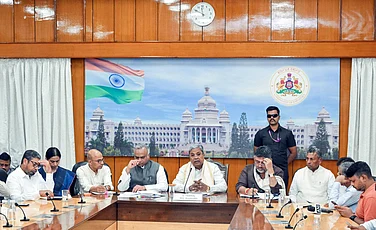In April 2022, the North Eastern Electrical Power Corporation (NEEPCO) issued a circular. It warned that the water levels in Ranganadi Dam were reaching dangerous levels. People living in the downstream area should stay away; otherwise, they would face “serious incidents at their own risk.” Flooding at Ranganadi dam has become a yearly phenomenon. In 2018, authorities were compelled to open three gates of this dam when the water levels reached a dangerous height. This caused massive flooding and as a result 76 villages were submerged.
This year, the flood in Assam has affected over 32 million people and left around 180 dead. The calamity has raised various questions, especially about big dam projects. As per a report by NewsClick, people in Raha, Kampur of Nagaon district, and Hojai district of Assam, were in an abysmal situation as the flood due to heavy rain was exacerbated by water released from various dams like Ranganadi Dam. Many studies have found that due to lack of operational rules and effective warning system, dams are actually aggravating floods, even though one of their functions is to moderate floods.
Take the case of the 2018 Kerala flood that killed 493 in the state, and affected millions of people. Advocate Jacob P Alex, the amicus curiae appointed by the Kerala high court in 2019 to assist it in flood-related cases, told the court that the intensity of the flood was aggravated due to the sudden release of water from different reservoirs during the torrential rains. India’s first Prime Minister Jawaharlal Nehru called huge dams “temples of modern India”. Apart from being a recreational spot, dams can easily absorb small and medium intensity floods. Kerala-based civil engineer, James Wilson, says, “Due to no occurrence of small floods, people start constructing on the floodplain of the river as they presume the area is safe.” When a high intensity flood occurs, people cannot anticipate the damage. Dumping of waste and unplanned construction on the riverbed intensify this damage. “Riverbeds are used for all kinds of wrong activities like dumping waste, illegal construction, and sand mining which make flooding even more damaging,” informs environmental activist and water expert Himanshu Thakkar.
“There is a need to measure the operational safety of dams,” says Wilson. “When we talk about dams, we are only concerned about hydraulic safety—if a dam is capable of managing the flow of water—and structural safety. How the dam is operated is often overlooked,” he adds. Dam operators are often not well-informed about weather prediction and rainfall patterns. On top of it, “no accountability” exacerbates the operational safety of the dam. “For flood moderation in downstream areas, the dam must be kept empty to a certain extent. Only then, it can absorb the flood. But dam operators don’t care until water rises to a high level,” says Thakkar.

Instead of moderating the flood (throughout the year), dam operators release water to the downstream area during the monsoon, when the water level rises. “Many dams are not designed for flood control. Most of these are multipurpose dams used for hydroelectric power, irrigation, etc,” says Wilson. So, the flood cushion—a temporary storage capacity—is often low. When high intensity floods occur, dams fail to absorb it and collapse, he adds.
ALSO READ: Monsoons And The Interpreter Of Melodies
One of the major causes is the smaller catchment area. “The catchment area of dams in the North east and Kerala is small, which adds to the problem,” says Wilson. He gives the example of Idukki Dam on the Periyar River in Kerala. The catchment area of Idukki Dam is only 650 sq km compared with Hirakud Dam, with a catchment area of 83,400 sq km. A bigger catchment area means more time to manage the flood.
There is a notion that “flood equals disaster”, which is completely wrong. People traditionally never saw floods as disasters. “We made it into a disaster,” says Thakkar. For the rivers Krishna, Ganga, and Brahmaputra, the flood used to spread out and deposit the silt carried over the floodplain, making it more fertile. When a dam is built on a river, silt and boulders get deposited in the dam. The water that flows over these deposits and the water that gets released from these dams is mostly silt-free or contains less silt. In geomorphology, this is called ‘hungry water’. “This hungry water makes the river flow faster and has much greater capacity to erode the downstream area, which again increases its damage capacity,” says Thakkar.
Flooding also depends on the quality of the catchment area, says Thakkar. If the catchment area includes good forest, watershed, wetlands, and maintains a lot of water bodies, then excessive rain will take much longer to convert into a river flow. But “due to mindless mining, construction, and deforestation, the catchment areas are getting destroyed,” informs Thakkar.
On top of this, climate change has altered rainfall patterns and they have intensified, even though there’s no significant change in the total quantum of rainfall. There are many high intensity rain events over short periods followed by long dry periods, “which is aggravating the intensity of the flood, and also making it tough to forecast,” adds Thakkar. Indian climatic conditions are creating further complications. “It is hard to predict rain. While the Indian Meteorological Department is working hard and rainfall is being predicted with more accuracy, it is still a challenge,” adds Wilson. That makes the area of operational safety of a dam even more important.
Another factor often overlooked, but has a crucial role in flooding is embankment—artificial banks built along rivers. The biggest example is the Kosi River, known by the metaphor “sorrow of Bihar” for creating floods. Journalist Kanak Mani Dixit writes in a 2020 article for Scroll that since the late 1950s, the connivance of politicians, technocrats and bureaucrats in Bihar is strengthening and protecting the embankments of Kosi River, which he calls a “mad idea”.
Bihar has witnessed over eight dangerous breaches of the embankments, since these were constructed. Thakkar believes embankments are temporary measures, bound to be breached. “It is not about ‘if’ the embankment will breach, but only a question of when and where it will breach. The point at which it breaches will create a massive flood.” Thakkar gives the example of Kosi and Brahmaputra, both high silt-carrying rivers. “Over the years, with the deposition of silt and sand, the riverbed levels in many places have gone up higher than the land surrounding it outside. Since the river is embanking all along, where will the water coming from higher to lower levels go? Naturally, it will create flooding.”
(This appeared in the print edition as "Hold the Gate!")


























